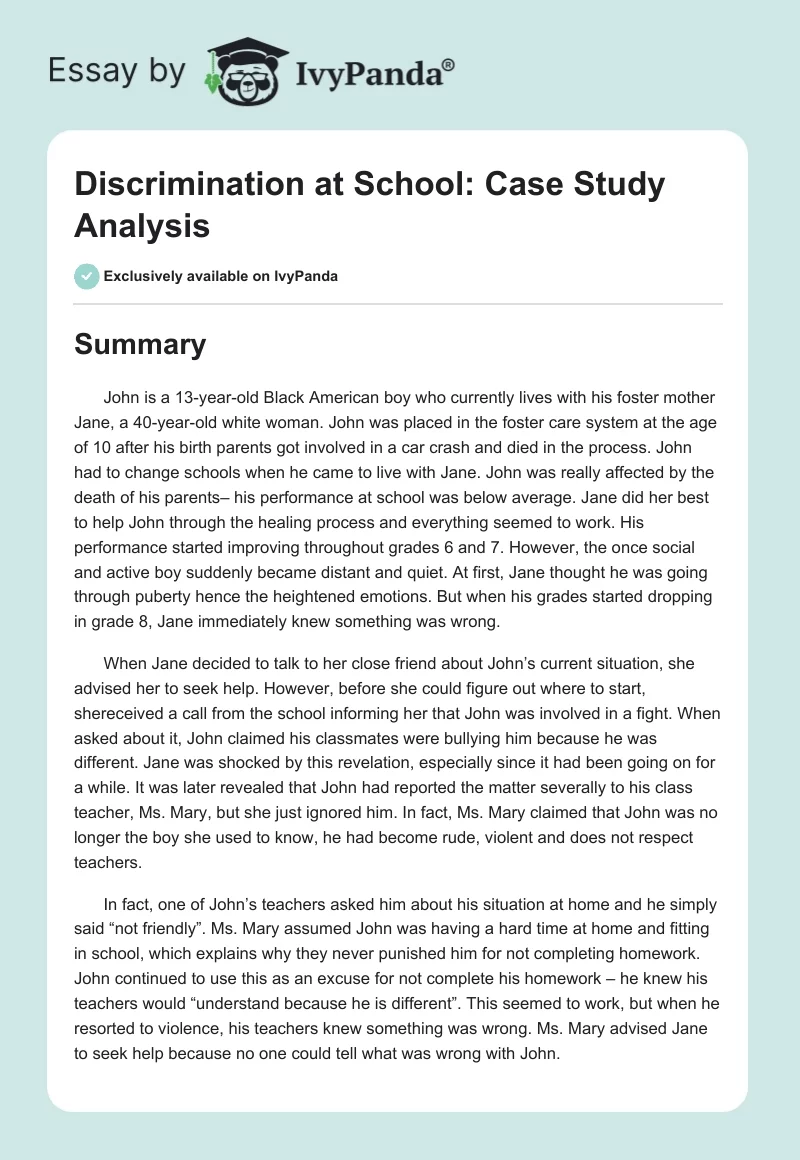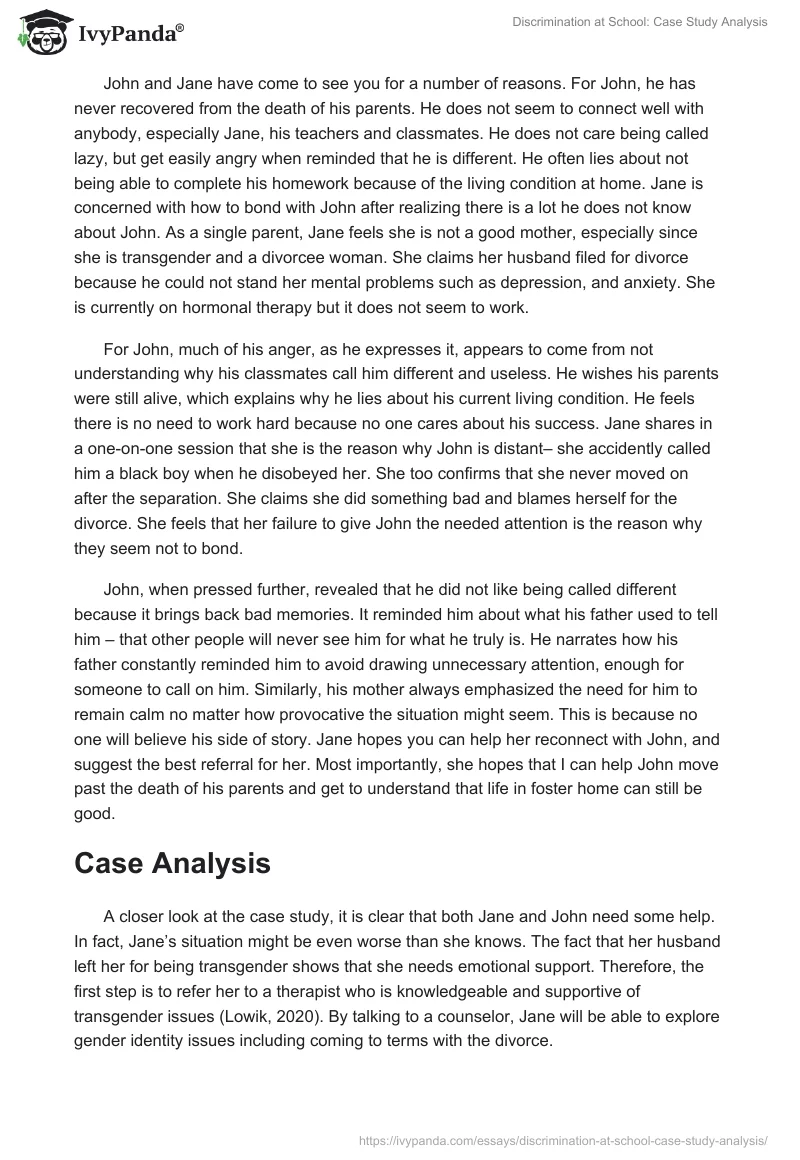Summary
John is a 13-year-old Black American boy who currently lives with his foster mother Jane, a 40-year-old white woman. John was placed in the foster care system at the age of 10 after his birth parents got involved in a car crash and died in the process. John had to change schools when he came to live with Jane. John was really affected by the death of his parents– his performance at school was below average. Jane did her best to help John through the healing process and everything seemed to work. His performance started improving throughout grades 6 and 7. However, the once social and active boy suddenly became distant and quiet. At first, Jane thought he was going through puberty hence the heightened emotions. But when his grades started dropping in grade 8, Jane immediately knew something was wrong.
When Jane decided to talk to her close friend about John’s current situation, she advised her to seek help. However, before she could figure out where to start, shereceived a call from the school informing her that John was involved in a fight. When asked about it, John claimed his classmates were bullying him because he was different. Jane was shocked by this revelation, especially since it had been going on for a while. It was later revealed that John had reported the matter severally to his class teacher, Ms. Mary, but she just ignored him. In fact, Ms. Mary claimed that John was no longer the boy she used to know, he had become rude, violent and does not respect teachers.
In fact, one of John’s teachers asked him about his situation at home and he simply said “not friendly”. Ms. Mary assumed John was having a hard time at home and fitting in school, which explains why they never punished him for not completing homework. John continued to use this as an excuse for not complete his homework – he knew his teachers would “understand because he is different”. This seemed to work, but when he resorted to violence, his teachers knew something was wrong. Ms. Mary advised Jane to seek help because no one could tell what was wrong with John.
John and Jane have come to see you for a number of reasons. For John, he has never recovered from the death of his parents. He does not seem to connect well with anybody, especially Jane, his teachers and classmates. He does not care being called lazy, but get easily angry when reminded that he is different. He often lies about not being able to complete his homework because of the living condition at home. Jane is concerned with how to bond with John after realizing there is a lot he does not know about John. As a single parent, Jane feels she is not a good mother, especially since she is transgender and a divorcee woman. She claims her husband filed for divorce because he could not stand her mental problems such as depression, and anxiety. She is currently on hormonal therapy but it does not seem to work.
For John, much of his anger, as he expresses it, appears to come from not understanding why his classmates call him different and useless. He wishes his parents were still alive, which explains why he lies about his current living condition. He feels there is no need to work hard because no one cares about his success. Jane shares in a one-on-one session that she is the reason why John is distant– she accidently called him a black boy when he disobeyed her. She too confirms that she never moved on after the separation. She claims she did something bad and blames herself for the divorce. She feels that her failure to give John the needed attention is the reason why they seem not to bond.
John, when pressed further, revealed that he did not like being called different because it brings back bad memories. It reminded him about what his father used to tell him – that other people will never see him for what he truly is. He narrates how his father constantly reminded him to avoid drawing unnecessary attention, enough for someone to call on him. Similarly, his mother always emphasized the need for him to remain calm no matter how provocative the situation might seem. This is because no one will believe his side of story. Jane hopes you can help her reconnect with John, and suggest the best referral for her. Most importantly, she hopes that I can help John move past the death of his parents and get to understand that life in foster home can still be good.
Case Analysis
A closer look at the case study, it is clear that both Jane and John need some help. In fact, Jane’s situation might be even worse than she knows. The fact that her husband left her for being transgender shows that she needs emotional support. Therefore, the first step is to refer her to a therapist who is knowledgeable and supportive of transgender issues (Lowik, 2020). By talking to a counselor, Jane will be able to explore gender identity issues including coming to terms with the divorce.
As for John, the best way to help him would require listening keenly and unpacking any racial related components in an attempt to find a solution. It is important to note that John did not mind being called lazy but resorted to violence when the classmate suggested he was different. Therefore, the aim is to help him learn how to cope with the racial stressors – something his father was doing before the car crash. Once the racial dilemma has been identified, the next step to help him process it and discuss the next steps if he encounters the same (Hazel, 2018). At this point, involving Jane would be the best option to help them connect and bond.
What Are the ‘People’s Needs
People choose to see a social worker because they play an important role of helping them through their social and interpersonal difficulties. Intersectionality, as described by Johnson (2013), Mountian (2017), Friedman et al. (2019) and May (2019), encourages social workers to reflect and value the diversity and unique qualities of each client. Therefore, an intersectional lens can inform social workers the likely needs of the clients. They include problems of cisgenderism, difficult live of a transgender person and fat oppression. For instance, intersectional perspective will help a social worker see body size discrimination with clarity and, in the process, strive to change the dominant discourse (Friedman et al., 2019). In addition to this, Jane and John want to see the social worker to help handle racial comments and heal from the divorce. These needs manifests from the way both Jane and John interpret the world and through lived experiences.
Positionality, Privilege, and Marginalization
My position as a social worker requires that I recognize the role that structural discrimination play in oppressing and marginalizing people of color, trans people and cisgenderism. The knowledge of client’s lived experienceas discussed by Shelton and Mallon (2021) will help a lot develop my cultural knowledge. Therefore, my focus, when attending to my clients such as Jane who is transgender, is to view her experiences through interpersonal actions. More specifically, my aim will be to change the oppressive ideologies and institutional structures that have persisted for long. Similarly, my work involves challenging oppression which allows me to focus on the ideological origins such as why John was labeled as different in the first place. It is by addressing the original that one can put in place measures to help client overcome their challenges. Therefore, as for Jane and John, my positionality will ensure that treat them with respect and offer culturally responsive solutions.
Key Issues or Principles Guiding Your Work
The key principles that guide my work as a social worker are expanding the social justice and Intersectionality analysis. Christensen and Sune (2012) emphasize the need to focus on life-story narratives and analysis of everyday life. This is one way of ensuring that identify the ideological origin of their problem. Expanding the social justice, on the other hand, compels me to look at the bigger picture. For instance, I might expand my clients’ reproductive rights to include incarceration and environmental justice. In the event my patients, such as Jane who is transgender require additional support, I would turn to informed consent framework which emphasizes patient knowledge of transgender issues. For instance, if she requires medical assistance with her hormonal therapy issues, I will refer her to a physician that she can trust and who understanding transgender challenges such as symptoms of nausea.
References
Christensen, A. D., & Jensen, S. Q. (2012). Doing intersectional analysis: Methodological implications for qualitative research. NORA-Nordic Journal of Feminist and Gender Research, 20(2), 109-125. Web.
Friedman, M., Rice, C., & Rinaldi, J. (Eds.). (2019). Thickening fat: Fat bodies, intersectionality, and social justice. Routledge.
Hazel, Y. P. (2018). Bla (c) k lives matter in Australia. Transition, 126(1), 59-67.
Johnson, J. R. (2013). Cisgender privilege, intersectionality, and the criminalization of CeCe McDonald: Why intercultural communication needs transgender studies. Journal of International and Intercultural Communication, 6(2), 135-144. Web.
Lowik, A. J. (2020). “Just because I don’t bleed, doesn’t mean I don’t go through it”: Expanding knowledge on trans and non-binary menstruators. International Journal of Transgender Health, 22(1-2), 113-125. Web.
Mountian, I. (2017). Borders and margins: debates on intersectionality for critical research. Qualitative Research Journal. Web.
Rice, C., Harrison, E., & Friedman, M. (2019). Doing justice to intersectionality in research. Cultural Studies↔ Critical Methodologies, 19(6), 409-420. Web.
Shelton, J., & Mallon, G. P. (Eds.). (2021). Social Work Practice with Transgender and Gender Expansive Youth. Routledge.


